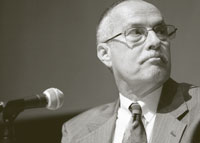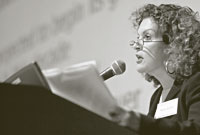Dollars and Sense
Beyond the numbers presented by researchers at the College's first
Symposium on Educational Equity, the two-day event was a free-ranging
debate on economics, morality, race and - to a very large degree -
messaging. No one disagreed with TC
President Arthur Levine's opening statement that "there is no more
important issue [than educational equity] facing the education arena
and no greater threat to the future of our nation." But in a
conference dominated by numbers, many speakers emphasized that
"We've got to make the moral argument as well as the economic one, because Americans still believe in equal opportunity, in Brown v. Board of Education," added Michael Rebell, Executive Director of The Campaign for Educational Equity. "Yet we're going in the wrong direction."
Certainly the economic case was strongly put - by Rebell himself, among others. "As [author and New York Times columnist] Tom Friedman has put it, globalization in the flat world that the computer has created is going to be a bonanza for knowledge workers," Rebell said. "Those who are properly educated will do well. It will be a disaster for those who are not, and a disaster for the economy. And this is the picture we're painting here today, in bolder colors than anyone has ever painted before."
President Bush's education program, No Child
Left Behind, is conceptually the right policy for the nation,
Rebell said, but implementation is alarmingly off course - particularly
for the program's mandated goal of all children being proficient in
state standards by 2014. Rebell cited the standardized test score
results recently released by the National Assessment of Educational
Progress (NAEP), which showed modest gains in reading and math
for fourth graders, but only minimal gains inmath and a decline
in reading foreighth graders. "The Times said that if we continue to
progress at the fourth grade rate, we'll hit the NCLB proficiency goals
in 2030, 20 years behind schedule," he said."If we continue to progress
at the eighth grade rate, it will take us 200 years to reach
proficiency. By that time the
Speaker after speaker urged society to think in terms of strategic investments - particularly around the issue of early childhood education.
"It
seems as if pre-schooling is one of the few things on which economists
almost all seem to agree," said Clive Belfield of
Yet even as the presenters quantified the dimensions of inadequate education and potential solutions, they took pains to document the degree of injustice and unfairness that underlies the issue. "There is a wealth of data about the gap in opportunities and outcomes between whites and all minorities, but we chose to focus on educational disparities between whites and blacks because of the historic roots of this gap in slavery," said Richard Rothstein, Tisch Professor, who along with graduate student Tamara Wilder discussed a range of factors in and outside of the classroom that stack the odds against black students. These include "glass ceilings and other labor market issues." State policies that effectively segregate black communities, families and students are also major contributors to the black-white gap, Rothstein said, as are inferior housing and housing stability, less substantial family assets, and poor health and health care.
Health discrepancies are especially pronounced - and shocking. Peter Muennig of
"People with less education are more stressed out," he said. "There's the stereotype of educated people having more things to do, and the stresses associated with that. But it turns out that there's more stress associated with not having enough money. In addition, wealth enables people to afford good health insurance, which makes a difference in survival rates, especially with all the new treatments now available."
Of course, all these inequities also limit the chances of new immigrants, who have historically looked to
"When my father came to
Jane Junn of
At the same time, members of minority groups need to improve their strategies for success, several researchers agreed.
"Ultimately, this is a problem black folks are going to have solve for themselves," said TC Professor Emeritus Edmund Gordon, who participated in a discussion panel at the symposium. Gordon urged the black community to revisit its history of supporting schools and universities for black students.
In a similar vein, Ronald Ferguson, of Harvard's
"I know kids whose social activities consist of talking about what they're reading,"
The consensus at the end of the two-day Symposium was that a problem with causes as diffuse as educational equity calls for an equally comprehensive solution.
"We should be talking about No Family Left Behind, and No Community Left Behind," Levin said.
But will Americans truly see educational equity as a moral imperative? Can the economic and moral arguments be linked in their minds?
Discussant Timothy Smeeding of
But presenter Ir win Garfinkel of Columbia's
Published Wednesday, Nov. 9, 2005

